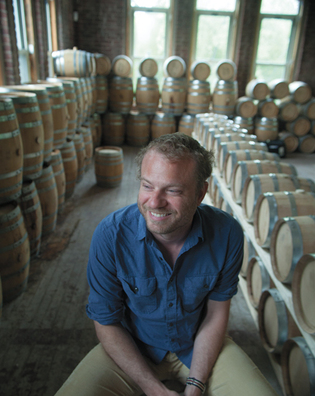 loading
loading
Where They Are NowA career in moonshineAn alum opens New York City’s first whiskey distillery since 1920. This interview has been condensed and edited.  Mark OstowWhen Colin Spoelman ’01 started making moonshine in his New York City apartment, he didn't expect to turn it into a business. Today he runs an organic-corn distillery in Brooklyn. View full imageColin Spoelman ’01 never expected to start a distillery. He had majored in theater and architecture, and after graduating he gravitated to New York and tried a series of different jobs—fund-raising at Columbia, temp work in marketing at Estée Lauder, a stint in the film industry. But after a visit back home to Harlan, Kentucky, he found his calling: making whiskey. In 2010, Spoelman and a partner launched Kings County Distillery (named for its Brooklyn location), the first whiskey manufacturer in New York since 1920. Y: You toiled for about six years in other jobs before becoming a full-time whiskey maker. What were the takeaways? S: The working world can be aggressively dull and repetitive. College had not prepared me for that. Y: Why did you choose to become an entrepreneur? S: There was no epiphany moment when I said, “Take this job and shove it.” I was pursuing several creative projects and this took off. I felt like I had ambition, but wasn’t quite sure where that would lead. I didn’t set out to start a business. Y: You’ve said whiskey was part of your roots. S: I’m from the coal-mining part of Kentucky, where several towns were dry, so a lot of those towns have historically had moonshine makers. When I was growing up, we often went to the bootlegger to buy commercial alcohol. It’s a very different culture than New York City. I was there directing a feature film, The Cave Movie. At the wrap party, one of my buddies, the drummer in my high school band, found some moonshine for the cast and crew from New York. I knew it would be interesting to them. But in fact, when they tasted it, it was bad. Real moonshine often isn’t very good. I had a bunch of moonshine left over and took it back to Brooklyn and brought it to parties. Despite the taste, people were compelled by it. They were curious and there was a mystique about it. Y: And you started making it in your apartment. S: It’s illegal to make moonshine anywhere in the US. By one definition, any spirit you make at home is moonshine, whether it is white whiskey, tequila, or gin. But I had the necessary disrespect for silly laws. What’s the big deal about making moonshine? It reflects an antiquated governmental priority. Y: What are the key ingredients? S: There’s no real recipe. I read Making Pure Corn Whiskey [by Ian Smiley, 2003]. I combined corn and malted barley. I played around in my kitchen to get the taste I wanted. Initially, what I made was like what I brought back from Kentucky, which was too harsh. New York City has a sophisticated culinary audience. I had to figure out how to make it taste good. The Kentucky stuff was like nail polish remover. Mine tasted like a bright corn, almost like a tequila. Y: Your friend David Haskell [’01], a features editor at New York magazine, got involved. S: We share the responsibilities of running a business equally, including raising money and sourcing equipment. The first product was moonshine, the same process and equipment that I used in my apartment, but now it’s made in a legal distillery. We started in a 300-square-foot room in East Williamsburg, Brooklyn. We raised $30,000 from friends and family to get the license. We spent about a third on legal costs, a third on equipment and a third on operating capital. To move into the Brooklyn Navy Yard [their current location], we had to raise more money, which was the equivalent of buying a small studio apartment in New York City. In August 2010, we sold to a liquor store in Williamsburg [in Brooklyn]. We did a tasting. We blasted an e-mail that said, “The first whiskey made in Brooklyn is on sale today; come pick up your commemorative bottle.” The response was enthusiastic. We stacked the deck with friends and family, but this was the first time whiskey made in New York City was being sold for almost a hundred years. Y: Is it profitable? S: We’re at break-even. The nature of the whiskey business is you don’t bank the profits. We reinvest the profits in longer-aged bourbon. But we’re firing up new stills and testing bigger equipment. We’re looking beyond the present moment and anticipating a demand for bigger stills and expanded space in the Brooklyn Navy Yard. We expect to double our current 1,000 barrels in 2014. Y: You majored in architecture and theater and turned into a whiskey maker. Is there a moral here? S: A liberal arts education encourages curiosity and creativity. I noticed a lack of those attributes in the spirits industry.
The comment period has expired.
|
|